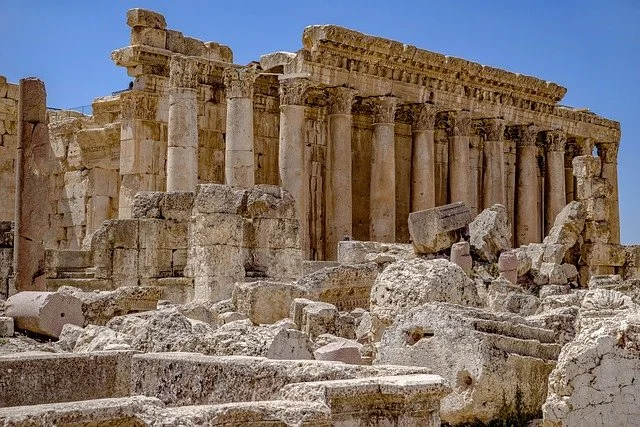What materials did the Romans use to build their structures?

What materials did the Romans use to build their structures? First and foremost, from the ground under their feet, i.e., from local materials. Natural stones, wood, raw and then burned bricks, sand, and pebbles were among the materials used in mortar and concrete.
Throughout Italy at the period, deciduous trees existed as massive “islands.” Many oak and beech trees, as well as maple, poplar, alder, and citrus trees, were present. However, as Ancient Rome’s dominance grew, woods were ruthlessly burned, thus impacting not just the country’s economy but also its environment.
Even the ancient Greeks divided wood into three categories. “Forest stuff may be sawn, hewn, and round,” according to Theophrastus, an ancient Greek scholar and the first botanist on the planet. Sawing is accomplished by sawing with a saw, hewn – the circular is left intact by removing the outside sections with an ax. Sawn wood, on the other hand, nearly never splits because the open core dries up and dies. “Ebony, cypress, and cedar are the most durable,” says Pliny the Elder.
Unfortunately, the Romans’ wooden constructions have perished. However, according to Vitruvius’ account, wood played a significant role in the ancient Roman state. When covering huge distances in structures or spans between bridge piers, it was commonly utilized as a structural material like posts, columns, decks, and trusses. Despite the exorbitant expense of metal, the Romans did replace wooden constructions with metal structures.

Wood was also frequently utilized as a supporting element in the form of complicated formwork and circles in the building of concrete vaults and domes, as well as scaffolds, scaffolding, staircases, and other similar devices. As ornamental finishes, the most precious kinds of wood were chosen. Pliny the Elder said that plywood was made from maple, beech, poplar, nodules from alder, elderberry roots, black, and citrus trees.
Natural stones were commonly employed as a construction material, particularly during Rome’s republican era. They were mined and processed from a range of rocks, ranging from light volcanic materials like tuff, pumice, and lava to hard, long-lasting limestone and porphyry.
These stones were used to build foundations and column drums, from which blocks of various sizes and shapes were manufactured for wall and architrave girder construction. Large portions of structures were often created without the use of mortar, despite the fact that the latter was already commonly employed in construction practice at the time. At the same time, enormous stone blocks were hewn with such precision that no further correction was necessary at the joints while constructing walls, for example.
These holes were then filled with molten lead, which was poured into grooves that had been left specifically for this reason.
For the construction of concrete, underlayment in road surfaces, and other reasons, a huge volume of crushed stone was needed. As a result, whole armies of slaves were tasked with processing it on a regular basis.

For the manufacturing of lime and gypsum, some rocks were employed as raw materials. They have to be mined and treated as well. While it comes to sand, Vitruvius advises, the first thing to do when laying rubble is to make sure that the sand is acceptable for the solution and does not include any mixing of dirt. Sea sand and other stone products are given similar suggestions.

Bronze and iron were among the metals the Romans used to build their structures. Furthermore, bronze was given higher priority since it was a generally durable and non-corroding construction element. It was used to create long, thin beams, which were then joined to form more sophisticated structural components, such as trusses.
Furthermore, in some instances, just the trusses’ primary structural components were constructed of bronze, while in others, they replaced full wooden sections and built the entire truss, including metal (bronze) pieces, up to the lathing. Iron was utilized to make a variety of assembly devices and components. “Clips” (dowels) and brackets for anchoring natural stones, iron nails, and other minor construction elements and devices were produced from it, as indicated above.
In the year 180 BC, NS. The Pergamon king Eumenes II, who was influenced by Rome at the period, authorized the building of a 3 km long pressurized water pipe. At the same time, owing to a height difference of 200 m, the operating pressure in the pipes should have been at least 20 X 105 Pa, as was determined in our time. Ordinary earthenware pipes were ineffective in this situation. Metal pipes, one meter long, are thought to have been utilized and put in drilled stones. The pipes were probably made of bronze.
Gold, silver, mercury, antimony, tin, and lead were all known to the Romans, in addition to bronze and iron. The latter two pieces were also utilized in the building of the structure. Pipes were known to be manufactured from bent lead sheets by brazing longitudinal seams and couplings, for example.
The Romans even implemented pipe uniformity in diameter and cross-section during the building of their famed water pipelines. The computation and design of the water supply network were made easier as a result of this. Lead was also employed to keep stone slabs together and seal seams, according to legend.
Terracotta goods, which were carefully burned forms of clay, were used to create various aspects of architectural constructions and ornamental design. A particular method was employed for terracotta items, which included a careful selection of components and rigorous adherence to a certain firing temperature.
Straw, pozzolana, and broken brick were all utilized as clay additions. The most common terracotta items were thin square bricks and tiles in a variety of forms, colors, and sizes, all of which possessed important properties including water resistance, strength, and durability. Some of its species have made through to our day in fine shape.
Raw brick, which had been widely used in the ancient Roman state until approximately the 1st century, started to be supplanted by heated brick. At the same period, three varieties of burnt bricks were available: triangular, square, and rectangular. Not rectangular, but triangular bricks are the most common in ordinary brickwork.

Square bricks were used for laying brick rows and joining wall rows, whereas rectangular bricks were utilized for masonry corners and wall joints. It should be noted that brick was given a specific role in the construction of concrete vaults and domes as a building material. Brick used as a formwork front in the walls, a supporting frame in vaults and domes, and so on.
The sides of the bricks did not have the same dimensions. A triangular brick had side dimensions ranging from 127 to 508 mm, rectangular bricks had lengths ranging from 254 to 381 mm and widths ranging from 101.6 to 152.4 mm, and square bricks had widths ranging from 762 to 838.2 mm.
At the same period, triangular and rectangular bricks ranged in height from 38.1 to 50.8 mm, while square bricks ranged from 50.8 to 88.9 mm. The height of the bricks in a row was usually considered to be the same, and seams were often thin.
It should be emphasized that there were no established standards regarding brick size at the time. This gave each producer the freedom to operate at their own discretion, governed mostly by the quality of the brick clay used in the production. However, since each brick had its unique manufacturer’s mark, it was always able to differentiate one batch of bricks from another if required.





